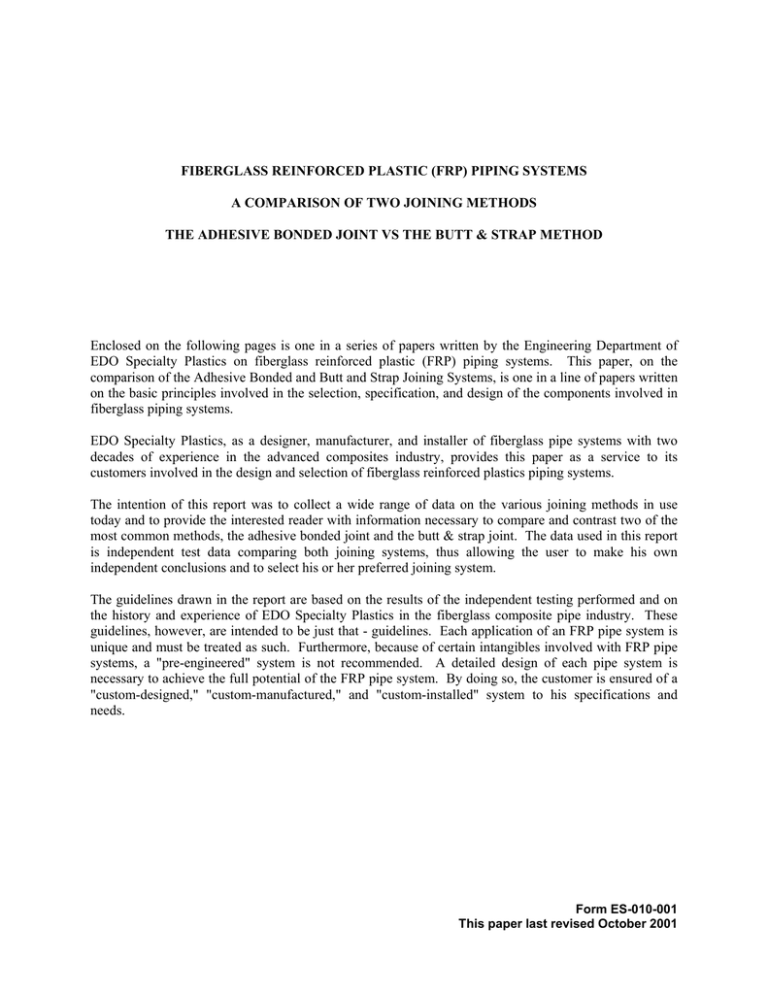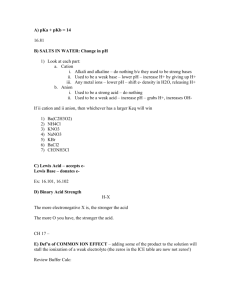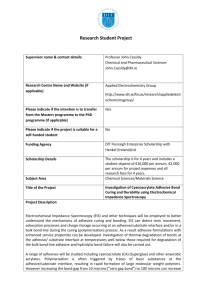FIBERGLASS REINFORCED PLASTIC (FRP) PIPING SYSTEMS
advertisement

FIBERGLASS REINFORCED PLASTIC (FRP) PIPING SYSTEMS A COMPARISON OF TWO JOINING METHODS THE ADHESIVE BONDED JOINT VS THE BUTT & STRAP METHOD Enclosed on the following pages is one in a series of papers written by the Engineering Department of EDO Specialty Plastics on fiberglass reinforced plastic (FRP) piping systems. This paper, on the comparison of the Adhesive Bonded and Butt and Strap Joining Systems, is one in a line of papers written on the basic principles involved in the selection, specification, and design of the components involved in fiberglass piping systems. EDO Specialty Plastics, as a designer, manufacturer, and installer of fiberglass pipe systems with two decades of experience in the advanced composites industry, provides this paper as a service to its customers involved in the design and selection of fiberglass reinforced plastics piping systems. The intention of this report was to collect a wide range of data on the various joining methods in use today and to provide the interested reader with information necessary to compare and contrast two of the most common methods, the adhesive bonded joint and the butt & strap joint. The data used in this report is independent test data comparing both joining systems, thus allowing the user to make his own independent conclusions and to select his or her preferred joining system. The guidelines drawn in the report are based on the results of the independent testing performed and on the history and experience of EDO Specialty Plastics in the fiberglass composite pipe industry. These guidelines, however, are intended to be just that - guidelines. Each application of an FRP pipe system is unique and must be treated as such. Furthermore, because of certain intangibles involved with FRP pipe systems, a "pre-engineered" system is not recommended. A detailed design of each pipe system is necessary to achieve the full potential of the FRP pipe system. By doing so, the customer is ensured of a "custom-designed," "custom-manufactured," and "custom-installed" system to his specifications and needs. Form ES-010-001 This paper last revised October 2001 EDO Specialty Plastics The Adhesive Bonded vs The Butt and Strap Engineering Series ES-010 Introduction: When investigating the use of fiberglass reinforced plastic (FRP) piping in the chemical, petrochemical, marine, and other industries, several decisions have to be made early on in the design of the piping system. These include the fabrication technique (filament winding vs hand-lay up, for example), the method of installation (flanged pipe vs plain end pipe, and field-fabricated vs shop-fabricated spools), and the joining system (adhesive-bonded vs butt and strap, for example), to name a few. The joining method used in a piping system can often determine the success or detriment of the system over its years of use, thus making it one of the more important factors in the engineering design of the system. The two most common methods are the adhesive-bonded joint and the butt and strap, or buttweld, joint. Each of these joining methods have advantages and disadvantages. This report will first give a description of each type of joint, provide an engineering comparison of the mechanical characteristics of each, tabulate the advantages and disadvantages, outline potential applications, and summarize with a set of selection process guidelines for choosing the joining method. The purpose of this report is to provide the interested reader with independent information comparing the qualities of the adhesive bonded and butt & strap joints and provide a set of guidelines for the joining system decision making process. This is but one of the many aspects of FRP piping systems that must be investigated before a successful design can be completed. Fabrication materials, pipe flexibility, and pipe strength are but a few of the additional aspects that should be considered. By reading and understanding the information in this report, one step of many is taken toward the successful design of a fiberglass pipe system. A Description of the Two Joining Methods: The Butt and Strap The butt and strap joining method (also known as the butt and wrap, the butt weld, and the reinforced overlay joint; and sometimes referred to as an adhesive) is the oldest and most reliable joining method in the industry today. The butt and strap is made as it is described - two pieces of pipe are butted together and layers of chopped strand mat and woven roving are wrapped around the pipe in a resin matrix. The weld is applied to the exterior of the pipe and, if accessible, the interior as well (usually on pipe larger than 18" nominal I.D.). Refer to Figure 1 for a typical butt weld joint. By using the same materials as the pipe, the butt weld joint can be designed with axial and bending strength properties equal to or superior than the pipe. Sometimes the butt and strap joint is referred to as an adhesive, as it is a mechanical, not a chemical, bond. However, the butt and strap should not be confused with the adhesive bonded joints described next. 1 Rev: October 2001 EDO Specialty Plastics The Adhesive Bonded vs The Butt and Strap Engineering Series ES-010 Figure 1. A typical butt weld or laminated joint. The Adhesive Bond A second type of joint was developed to act as a "joint of convenience" in the industry. This is the adhesive bonded joint. There are three common types of adhesive bonded joints: 1) taper by taper, 2) straight by taper, and 3) straight by straight. These three joints are shown and described in Figure 2. The taper by taper joint uses a fitting with a tapered I.D. and a pipe with a tapered O.D., matched and joined by a thin glue line. This joint is slower to make than the other joints, but it is the strongest of the adhesive-bonded joints. A compromise to the taper by taper is the straight by taper joint which replaces the pipe's tapered O.D. with a plain end uniform O.D. Less installation time is involved, but a thin glue line is not always ensured, thus compromising strength. The straight by straight adhesive-bonded joint has no tapered surfaces. Medium strength is achieved with this joint while requiring fewer tools and less fit-up time. When any of these joining methods is used, it is important to follow the procedures recommended by the manufacturer. Any joint, improperly made, will be a poor joint, and will lead to maintenance costs down the road. 2 Rev: October 2001 EDO Specialty Plastics The Adhesive Bonded vs The Butt and Strap Engineering Series ES-010 Figure 2. Three different adhesive bonded joints: 1) the taper by taper, 2) straight by straight, and 3) straight by taper. Each joint uses a glue to bond the pipe to the fitting. 3 Rev: October 2001 EDO Specialty Plastics The Adhesive Bonded vs The Butt and Strap Engineering Series ES-010 An Engineering Comparison of Each Joining System: Tests have been performed over the years on pipe, fittings, and joints. Under a Small Business Innovation Research (SBIR) contract, a research project entitled "Composite Piping Systems - Phase II" involved the comparison of adhesive bonded and butt and strap joining systems. The results of this research are used as the basis for this report. The data in this report is deemed fair and accurate because 1) it involved the comparison of both common joining systems, the adhesive bonded and butt and strap, under scientifically reproducible conditions, 2) it involved the comparison of both joints used on the same specification of pipe, thus allowing a direct comparison of the joints independently, and 3) the tests were performed independently, at Louisiana State University. Several comparisons were made in the report between the two joining methods. Two experimental tests that were performed compared the joining systems as they were loaded in tension and bending. These are described below. Extracting these results from the report, two comparisons have been made in field applications, comparing how each system would perform under operating conditions. These are also described below. Ultimate Tensile Strength: First off, the joints can be tested in pure tension. The results of such tests are shown in Figure 3 along with bending test results. While the butt and strap joint is stronger than any of the other samples, the taper by taper adhesive bonded joint is only slightly weaker, thus proving the tensile strength of the taper by taper adhesive bonded joint. The other two adhesives, straight by taper and straight by straight, fared well, but were inferior to the two other joints. Ultimate Bending Strength: While all of the adhesive bonded joints lag only slightly behind the butt & strap under tensile conditions, there is a significant drop when tested in bending. The bending data can be used to compare the maximum allowable bending moment in each pipe sample. Refer to Figure 3 and Calculation Sheet 1 for the comparison. It is evident that by utilizing the butt and strap joining method, the joint can actually provide bending strengths superior to the pipe, thus making the entire system superior to any adhesive bonded system. Allowable Wind Loads: Not only do experimental tests show the superior strength of the butt and strap system over adhesive bonded joints, but field comparisons produce the same results. The first comparison is of a piping system supported in a rack that is subjected to wind loads. For comparison purposes, a section of this system can be described with a free body diagram, as shown on Calculation Sheet 2. The results have been graphically represented in Figure 4. 4 Rev: October 2001 EDO Specialty Plastics The Adhesive Bonded vs The Butt and Strap Engineering Series ES-010 Maximum Bending Loads Max. Load (lb) 25000 20000 15000 Tensile Loads 10000 Bending Loads 5000 0 Straight by Taper by Taper FIBERBOND® Taper Socket Socket Butt Weld Figure 3. While tensile (and pressure) tests often show little discrepancy between the two joining systems, the butt and strap is clearly superior when loaded in bending. Even in a properly supported system, adhesive bond failure is common. Wind Load (psf or mph) Maximum Wind Loads 250 200 150 Wind Load (psf) 100 Wind Load (mph) 50 0 Straight by Taper by Taper FIBERBOND® Taper Socket Socket Butt Weld Figure 4. A comparison of the maximum wind loads each joint is capable of withstanding. Because of the butt and strap’s superior bending strength, it is much stronger than any adhesive bonded system, thus allowing fewer structural steel supports. 5 Rev: October 2001 EDO Specialty Plastics The Adhesive Bonded vs The Butt and Strap Engineering Series ES-010 Maximum Thermal Loads Thermal Load (lbs) 20000 15000 10000 Thermal Load 5000 0 Straight by Taper Socket Taper by Taper FIBERBOND® Socket Butt Weld Figure 5. A comparison of the maximum thermal loads that each joining system can withstand. Because the butt & strap has a bending strength equal to or greater than the pipe, the piping system with this joint is superior to the adhesive bonded joint. Allowable Thermal Loads: Another field comparison of the two joining methods is of the typical allowable thermal loads that each joint can withstand. Consider a direction change in a piping system as shown on Calculation Sheet 3. On a properly guided and supported system, the pipe will flex due to the thermal expansion in the pipe wall. Such an expansion creates stresses in the pipe. Because the butt and strap joint is as strong or stronger than the pipe in bending, this joint becomes much stronger than the adhesive bonded joint, as shown in Figure 5. 6 Rev: October 2001 EDO Specialty Plastics The Adhesive Bonded vs The Butt and Strap Engineering Series ES-010 Advantages and Disadvantages of Each Joining System: Each joining method, the adhesive bonded and butt and strap, has their respective pluses and minuses, and it is these characteristics that should be remembered when selecting the preferred joining system. Adhesive Bonded Jointing System: Advantages: Can have a lower first time cost Less labor intensive Good under simple tensile and pressure testing Under extremely adverse installation conditions, may be preferred over the butt & strap Disadvantages: Less reliable joining method NDT, outside of field hydrotesting and some X-ray, unavailable Very weak under bending loads Installation time can equal the butt & strap Experienced knowledge of joining method required to obtain a reliable joint Special tooling may be required Normally requires passive fire protection when exposed to fire conditions There are always other intangibles involved in each joining system that can not be directly compared, as they apply only in certain situations. For example, one possible detriment of the adhesive bonded joint is the possible buildup of excessive glue which can actually drip inside the pipe and prevent smooth flow of the fluid inside (in some cases, this can actually occur with the butt and strap joint). Also, each joint has a respective cure time, when the joint is still weak. During this period the joint must be protected to prevent damage to the weld. These intangibles, though they should be considered in the joint system selection, are minor points compared to those tabulated above. 7 Rev: October 2001 EDO Specialty Plastics The Adhesive Bonded vs The Butt and Strap Engineering Series ES-010 Butt and Strap Joining System: Advantages: Most reliable joining method Excellent mechanical properties By utilizing the same materials in the pipe, the butt & strap has axial and bending strengths equal to or greater than the pipe No special tooling required When exposed to certain fire conditions, a fire retardant version of the joint may not require additional passive fire protection Disadvantages: Can have a higher first time cost Labor intensive Some installation experience required NDT limited to visual inspection, cure testing, and hydrotesting No matter which joining system is chosen, be it butt and strap or adhesive bonded, one statement is always true - joints that are made in the shop are more economical than joints made in the field. On a good day in the field, three hours of field time is equivalent to one hour of shop time, i.e., three shops joints can be made in the same time it takes to make one field joint. Thus, it is always recommended to utilize as much shop-fabrication of spools as possible to minimize field installation. Potential Applications for Each Joining System: It is not the intent of this report to draw conclusions from the information presented above. Rather, the decision on which joining system to choose is left up to the user. There are, however, certain applications that merit the use of one joining method over the other. In general, the butt and strap joint is recommended for all essential services necessary to ensure the safety of the plant and those piping systems that are instrumental to the operation of the facility. It is also recommended for those piping systems subjected to severe mechanical loads, such as high temperature pipe systems and pipe systems installed outdoors where they are subject to wind loads. 8 Rev: October 2001 EDO Specialty Plastics The Adhesive Bonded vs The Butt and Strap Engineering Series ES-010 While the butt and strap is certainly capable of performing in almost any FRP application, and while it is the joining system of choice in many plants, there are certain applications where an adhesive bonded joint might suffice. The adhesive bonded joint, because of its lower first time cost and ease of installation, is recommended for those non-essential services such as drain and vent lines and other non-critical piping systems where the loads induced on the system are very low. *** Although each joining system has its advantages and disadvantages, no fiberglass piping system can be successful without proper engineering design. Any system that is not engineered will be subject to detriment over its service life. It has become commonplace to treat fiberglass pipe systems as a custom product, not a "commodity" or "pre-engineered" product. *** *** While many feel the adhesive bonded joint has its applications, EDO Specialty Plastics, as a designer, manufacturer, and installer of fiberglass pipe systems, will always recommend the butt and strap joint over the adhesive bonded joint. The butt and strap is clearly superior in all mechanical respects and is the more reliable joint of the two. *** Selection Process Guidelines: To summarize the information presented in this report, a set of criteria has been tabulated below. These criteria make up many, but not all of the considerations that need to be taken into account during the selection process. By answering each of the questions, the user can have a better idea of which joint system to choose. How long will the piping system be in service? The butt and strap joining method has been proven over the years to be the most reliable joint in the industry today, thus giving it a significant advantage in life expectancy and reliability. For piping systems with expected shorter operation time, the adhesive bonded joint may be advantageous due to its lower cost. Will hand actuated valves, such as butterfly valves, be used in the FRP pipe system? Although flanges are a possible weak link in any FRP piping system, the strength of the butt and strap over the adhesive bonded joint gives it an advantage in this respect. The butt and strap, used with contact molded stub flanges, provides the excellent strength needed at valve connections. Adhesive bonded joints can be used, however, additional supports may be required at valve locations. 9 Rev: October 2001 EDO Specialty Plastics The Adhesive Bonded vs The Butt and Strap Engineering Series ES-010 What is the pressure rating of the piping system? What is the design temperature? For internal pressure alone, the adhesive bonded joint may be superior to the butt and strap. However, when additional axial and bending loads are applied to the system, the overall strength of the butt and strap may prove superior. For vent and drain lines, the cost advantage of the adhesive bonded joint makes it the preferred choice over the butt and strap. Is the piping system part of an essential service, such as a fire water system or a cooling water line? Or is it a non-critical piping system? The butt and strap joint is recommended for all essential services where plant and personnel safety is required. The adhesive bonded joint should only be used for noncritical piping systems. Will the piping system be installed outdoors, where it is exposed to wind? The butt and strap joint, with its superior bending strength, is recommended for systems that are exposed to hurricane force winds. If an adhesive bonded joint were installed in its place, additional structural steel would be required to guide the system properly, thus making it less cost effective. 10 Rev: October 2001 EDO Specialty Plastics The Adhesive Bonded vs The Butt and Strap Engineering Series ES-010 SUPPORTING ENGINEERING CALCULATIONS Shear and Moment Diagram for 3-Point Bending Test F A B C R1 R2 8" Assumptions: None 20" Equations: Bending Moment Shear + A C B x - + A B C x F * 20 28 F *8 R2 = 28 F * 20 * x M AB = 28 F * 8 * ( 28 − x) M BC = 28 R1 = F - Load applied by testing equipment, lbs R1, R2 - Reactions at pipe supports, lbs M - Moment, in.-lbs Results: Maximum Moment: Taper by Taper Adhesive: Straight by Taper Adhesive #1: Straight by Taper Adhesive #2: FIBERBOND® Butt Weld: 30,183 in.-lbs 39,206 in.-lbs 42,131 in.-lbs 98,400 in.-lbs 11 Rev: October 2001 EDO Specialty Plastics The Adhesive Bonded vs The Butt and Strap Engineering Series ES-010 SUPPORTING ENGINEERING CALCULATIONS Typical Allowable Wind Loads Guide Spacing Wind Load, w Assumptions: For simplified calculations, make the following assumptions: 1. Treat the system as simply supported in the horizontal direction. 2. Calculate the wind loads across one pipe section. Equations: M Max L L w* * 2 2 = 2 w - Wind Loads, lbs per ft L - Guide Spacing, ft Results: For a guide spacing of 20-feet, the allowable wind loads are: Taper by Taper Adhesive: 50.4 lbs/in., equivalent to 82mph wind load Straight by Taper Adhesive #1: 64.8 lbs/in., equivalent to 93mph wind load Straight by Taper Adhesive #2: 70.8 lbs/in., equivalent to 97mph wind load FIBERBOND® Butt Weld: 164.4 lbs/in., equivalent to 148mph wind load Wind loads in mph are calculated based on 12"NB pipe with a safety factor of 2.0 using the equations in ASCE7-88. 12 Rev: October 2001 EDO Specialty Plastics The Adhesive Bonded vs The Butt and Strap Engineering Series ES-010 SUPPORTING ENGINEERING CALCULATIONS Typical Allowable Thermal Loads 2'-0" 1'-6" Expansion of bend due to thermal loads 4"NB Guide Assumptions: For simplified calculations, make the following assumptions: 1. Treat leg BC as a cantilever beam resisting an end load due to thermal expansion. 2. Calculate the maximum moment at the bonded connection on the elbow. The elbow is a LR elbow, takeout of 6". Equations: M Max = − F * L M AtFitting = − F * (18 − 24) Anchor F - Thermal load, lbs Results: The allowable thermal load that can be withstood by the piping system is: Taper by Taper Adhesive: 5,081lbs or 29F temperature change Straight by Taper Adhesive #1: 6,534lbs or 38F temperature change Straight by Taper Adhesive #2: 16,400lbs or 94F temperature change FIBERBOND® Butt Weld: 7,022lbs or 40F temperature change Temperature change is calculated based on 4"NB pipe, 1,400,000psi modulus, and 0.00001in./in./F thermal expansion coefficient. 13 Rev: October 2001




